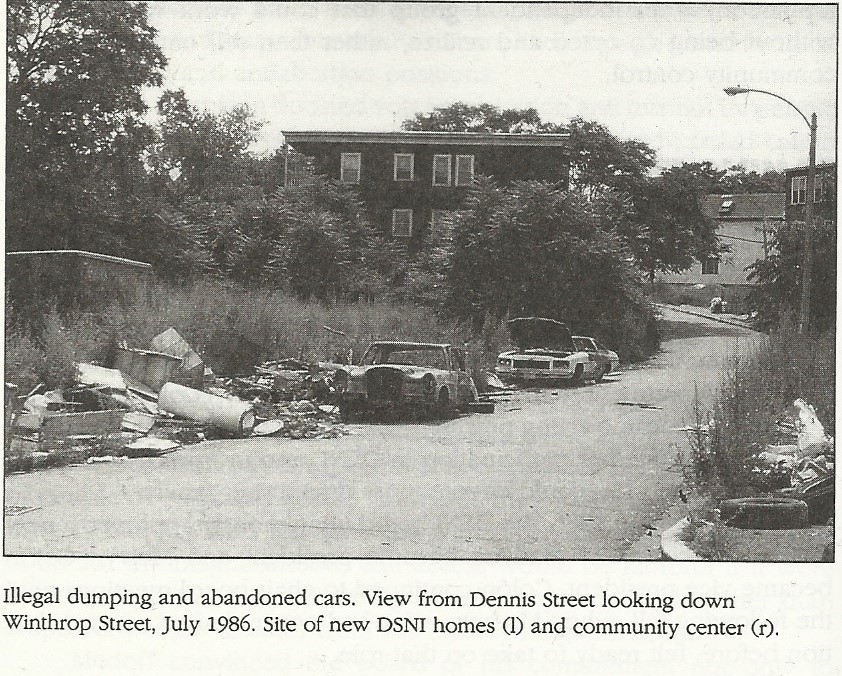Dudley and Roxbury

Illegal dumping and abandoned cars. View from Dennis Street looking down Winthrop Street, July 1986. Site of new DSNI homes (l) and community center (r). Courtesy of Peter Medoff and Holly Sklar, Streets of Hope: the fall and rise of an urban neighborhood.
“A monument to racism and neglect”
According to the Boston Globe, in the late 1980s the Roxbury neighborhood “was one of the most blighted places in the country, a monument to racism and neglect.”[1] The urban woes of the U.S. during the 1960s and 1970s hit communities like Roxbury hard. Government retrenchment, reductions in city services, decay of urban infrastructure, and extreme segregation all plagued the city of Boston in general. These negative forces converged on the residents and businesses of Roxbury in particular.
The population of Dudley was showing significant stress by 1980. Poverty, especially youth poverty, far outpaced the rest of Boston. In 1980 the poverty rate Dudley was 31%[2] The rate for Boston overall was 19% that census year.[3] The unemployment rate was double the unemployment rate of the rest of Boston, starting at 6.1% in 1960 and reaching 16.3% by 1990.[4] The white population of Dudley dropped from almost 95% in 1950 to just over 14% by 1990, while the black population increased from under 5% to almost 55% in the same time. However, at the same time, the overall population of the neighborhood decreased by 40%.
A disinvestment process that was seen in hundreds of inner city neighborhoods across the country was producing a downward spiral in Dudley. The cycle of disinvestment typically starts with the exodus of middle-class and working-class homeowners and renters. Banks and other institutions that control real estate lending reduce their investments in the community. An increased proportion of slum landlords and real estate speculators take over, milking money out of deteriorating properties using tax breaks to reduce costs and having a long-term eye on neighborhood revival and land value increases decades down the road.
Beyond the deterioration of buildings that resulted from this disinvestment process, to add insult to injury the Dudley neighborhood became an illegal waste dumping ground. Waste removal companies used the large number of vacant parcels as dumps or illegal garbage transfer stations. This was further reinforced by private individuals from outside the neighborhood who would simply drive in during the night to leave behind trash, abandoned cars, or old refrigerators. One resident complained of restaurants dumping old expired meat, leaving it to rot in the lot next to her building.[5] Tony Hernandez, a lifelong Dudley resident described the neighborhood as having become a “virtual landfill for surrounding communities.” (Tony Hernandez)[6]
Residents of Roxbury and other surrounding neighborhoods felt so alienated from Boston City politics and efforts at economic development that Roxbury activists placed a non-binding referendum on the ballot in 1986 to secede from Boston to create a separate municipality called Mandela, Massachusetts.[7] A local artist even wrote a rap song in support of the proposal.
View TV report on referendum and rap song

[1] Abraham, Yvonne. 2014. “Trust and Transformation in a Roxbury Neighborhood.” Boston Globe, July 24. Accessed August 4, 2015 (https://www.bostonglobe.com/metro/2014/07/23/roxbury-neighborhood-once-monument-racism-and-neglect-undergoes-transformation/QcWotBYJZYGoZD3OU4u0lO/story.html)
[2] This is the poverty rate for what is known as the Dudley Village Campus, which is the larger community in which the Dudley Street Triangle eminent domain initiative took place. Lee Allen Dwyer, Mapping Impact: An Analysis of the Dudley Street Neighborhood Initiative Land Trust. MA Thesis in City Planning, MIT. 2015, p. 81. https://dusp.mit.edu/sites/dusp.mit.edu/files/attachments/news/Dwyer_Thesis_FINAL.compressed.pdf Accessed January 31, 2016.
[3] University of Wisconsin-Milwaukee Center for Economic Development. “The Economic State of Milwaukee: The City and the Region,” Chapter 4: Poverty, Table 4.1 (Proportion of Population in Poverty-Cities, 1970-1990). https://www4.uwm.edu/ced/publications/milwecon/chap4.cfm Accessed January 31, 2016.
[4] Medoff, Peter and Holly Sklar. 1999. Streets of Hope: The Fall and Rise of an Urban Neighborhood. South End Press.
[5] Leah Mahan and Mark Lipman. Holding Ground. Blooming Grove, NY: New Day Films. 1996. (http://holdinggroundproductions.com/)
[6] All subjects interviewed for the project are listed at the end of the essay.
[7] Shlachter, Barry. 1986. “Irate Blacks Pushing for Secession in Boston.” LA Times, September 7 Associated Press, LA times, Sept 7. Accessed August 4, 2015 (http://articles.latimes.com/1986-09-07/news/mn-12197_1_boston-blacks)

